| From traditional to modern silverware in Greece
Текстове: Луиза Карапидаки
Down to the Second World War, silver jewellery in Greece gave expression mainly to the artistic trends and economic circumstances of its place of manufacture. On the periphery, jewellery was an indispensable complement to traditional costume, and a favourite item at events connected with the spiritual and social life of the Greek people.
In post-war Greece, silversmiths underwent an identity crisis, as all the familiar reference points of their profession changed. The rhythm and needs of post-war life at both the social and the economic level dictated fresh aesthetic approaches to jewellery.
In the 1960s and 1970s, a period characterised by a 'return to the roots', silver was worked systematically to make copies of ancient and Byzantine jewellery, and also 'modern' creations, which diffidently made their appearance. At the same period silver-workshops flourished with the rise of tourism and an increase in the output of tourist goods - that is, items designed exclusively for visitors and specially made as souvenirs.
In the 1980s many new silversmiths appeared on the scene and opened up new horizons for this art, giving silver-working a new dimension as they moved on from artistic handicrafts to art.
Alongside the flourishing production of silver jewellery, there was also an increase in the output of silver vessels, which the aesthetic and social rules of the day increasingly demanded. Decorative silver items and functional vessels found a new, dynamic purchasing public and accordingly saw a great increase in output, whether they were produced by local small or family enterprises.
Today, silver-working in Greece is characterised by elaborate pieces created by artists and also items made by traditional, skilled craftsmen, who continue to produce traditional creations, even though they are not aimed at the same audience.
Traditional techniques are used by contemporary silversmiths, and the search for and implementation of these techniques is often a source of inspiration.
The use of new materials and the combination of silver with other metals produce a different aesthetic result that reflects modern society and the needs of modern life.
Many modern artists continue their cultural heritage, using techniques handed down by their fathers in their inspired creations, and protecting the art of silver-working from lifeless copies.
Silver-working as a visual art, producing artworks or artistic handicrafts, is represented by items that reveal a concerned involvement with art and technique, and which follow the international currents of modern art.
Modern Artists said:
Dimitris Nikolaidis
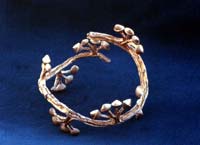 "Techniques: embossing, repousse, engraving, using thin leaves of metal. "Techniques: embossing, repousse, engraving, using thin leaves of metal.
The Greek word kosmos, which is the root of the Greek word for jewellery (kosmema), refers to a system of formal relationships and structures based on what is called nature.
Natural forms with shape, colour and texture, and the manner in which they were represented by the ancient civilisations of the Aegean, formed the standard for the creations of silver-working.
The complexity of jewellery manufacture, which is concealed behind the austerity of its form, and the method by which it is given shape are not conducive to its jewellery. The desideratum is to create artefacts that are equal in aesthetic terms to natural objects, with distinctly human origins."
Despina Pantazopoulou
 "I am often inspired by tradition, by techniques that served minorities and flourished under circumstances in which they were subject to various influences, simply so that the past will not be completely obliterated. "I am often inspired by tradition, by techniques that served minorities and flourished under circumstances in which they were subject to various influences, simply so that the past will not be completely obliterated.
As these techniques re-emerge, I use them to serve my own ideas and artistic aspirations.
I add colour by using savati (a form of enamel), and texture and form when I work in repousse, using hammer or chisel, resistance to resistance, just as others used the same means to work relief Gospel Books, serving religious and social purposes.
I want the application of these techniques to be moving and allude to something new; the idea in the final jewel should fortify and educate the public.
Since I also use my sense of touch, I resist rapid changes and try to ensure that my work is symbolic, not graphic, to the point of being abstract. I try to attract the public's interest, to make it intelligent and demanding."
Korinna Politi-Koutouzi
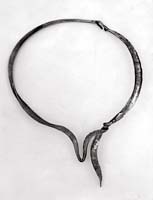 "Of the traditional silver-working techniques, I have used the ones that have enabled me on each particular occasion to arrive at the best formulation of what I have set myself to make. "Of the traditional silver-working techniques, I have used the ones that have enabled me on each particular occasion to arrive at the best formulation of what I have set myself to make.
It is one thing to mould soft wax to make miniature sculptures, or for many pieces to emerge from a mould, and quite another to shape a form from the material of hard metal.
In 1982 I began to forge metal on the anvil (mainly wire). This technique led me to more abstract and geometric forms.
Forging gives the metal elasticity, it returns to its position instead of bending. I normally exploit this feature, for example, to secure an earring or to make simpler clasps.
The choice of cheap metals enables me to be certain that the public appreciates my pieces for the design and the quality of my workmanship, and not for the value of the metal.
My material and I are two equal units who sometimes wrestle with each other and sometimes collaborate. This relationship ensures constant surprises and satisfaction."
Akis Goumas
 "
Every time I leave a museum, I have a thought in my head. Our forefathers did well to bequeath us this inheritance. But what do we have that will live on. Copies or combinations, assemblages and compositions of pieces that already exist? "
Every time I leave a museum, I have a thought in my head. Our forefathers did well to bequeath us this inheritance. But what do we have that will live on. Copies or combinations, assemblages and compositions of pieces that already exist?
What is it that makes these works of men so significant, that they are still today sources of inspiration? A question, answer or answers.
Talking to myself and attempting on occasion to tread the conceptual paths followed by these great creative artists, I discerned for myself a number of explanations. Powers of observation.
Technical ideas:
The way of life of these people was completely different from our own. I want to believe that they had a special relationship with things that interested them and with their environment. The concept of time had a different meaning for them than it does for us. Observation and inquisitiveness must have played a dominant role in their daily life.
The spirituality and life that inhered in everything they did gave it a completely different dimension from the one we understand today. If, given today's background, we imagine a combination of love, the quest for knowledge and spirituality, then we are probably coming close to their work.
All this combined with a knowledge of their techniques and tools impelled them to make the great stride forward, and we now arrive at conclusions as to how they worked that are mistaken and misleading.
Their close relationship with the nature of things inspired them and influenced everything they did. From the most minute detail of a flower to the picture of an animal or of man himself, they set out to create their own world, with their own expressive means, knowledge and techniques.
Through observing, they sought in everything around them for rhythm and life, for they saw that it exists in everything that grows, whether it is a micro-organism, insect, plant, animal, or even man himself. Techniques and implements are the result that emerged from man's need to create and give rounded form to what had been presented to him as an idea.
The evolution of tools led to the application of specific techniques in implementing any idea. The converse is probably true, when a technique opens up new roads and demands the evolution of the tools.
I have the impression that in many cases the evolution of tools was more important than the artefacts themselves. The idea, in the form of inspiration, (I have the feeling) is the result that is produced in a human being when he works with his inner self on a path (thought).
Here I believe is the nucleus of the creative act. That everyone of us processes at an intellectual level what is happening around us; everyone may form his own history and have the ability to express it.
All these thoughts and questions make me consider how important it is for me to search first for what I want to say and then for a way to express it.
If I try to convey in a few words my opinion on the importance of tradition."
Erato Boukoyanni
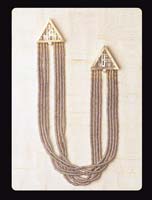 "My decision to work with jewellery started with my interest in the history of mankind and of cultures. From the first 'mastercraftsman' who hung a seashell on his neck to the present day, a vast number of such masters have walked the earth, imaginative, humble, intelligent, patient and confident with a great love of life. "My decision to work with jewellery started with my interest in the history of mankind and of cultures. From the first 'mastercraftsman' who hung a seashell on his neck to the present day, a vast number of such masters have walked the earth, imaginative, humble, intelligent, patient and confident with a great love of life.
I often feel the need to say thank you to them.
Thank you because they taught me and initiated me into an art, an idea, and act.
Thank you because they impelled me to go a long way to search for my own paths.
Thank you because they pulled me back.
Their work is an inexhaustible source of inspiration and knowledge, a firm base on which to stand, and also to kick.
After at least 25 years of continual involvement with jewellery, I still feel the same emotion, joy, thrill, and awe."
Savas Dimos
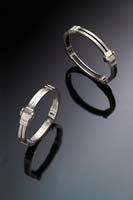 Savas Dimos, 1963, Silver artist. Descendant of a local Epirot silver craftstmen family. As a child his favourite game was to mold metals. He studied at the public school of Silver art and was tought how to design at the Tasos Rigas school of Art. He has worked for well known jewelry houses. For the past few years he has been working in partnership with the Benaki Museum. Savas Dimos, 1963, Silver artist. Descendant of a local Epirot silver craftstmen family. As a child his favourite game was to mold metals. He studied at the public school of Silver art and was tought how to design at the Tasos Rigas school of Art. He has worked for well known jewelry houses. For the past few years he has been working in partnership with the Benaki Museum.
His creations have been presented at the "Olive commendation to the ancient olive grove" exhibition that was organized by the Athens Academy in Athens during 2004. and again on the same year during the Cultural Olympiad at the "Foldings" exhibition at the new Benaki Museum building. In September 2005, he will take part at the international exhibition for young designers at the Byzantine Museum of Ioannina while his work can be viewed online at the Silver Art: European Heritage and Modern Design website.
He designs and creates jewellery and small art items by working on precious metals. His prototypes are considered artifacts of microsclupting. The original handmade creations on gold, white gold and silver are essentially characterized by forms that are simple and geometrical. His designs make reference to the modern mechanized society we live in, while at the same time they are inspired by the Greek art.
B&B Giotis
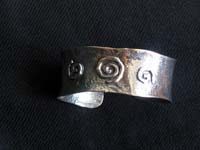 The art of brothers Giotis demonstrates strong aesthetic references to the Epirot silverware tradition. At the same time, the plastic interventions in cast or forged jewellery, demonstrate strong suppleness and original modern forms. Хngraved decoration and perforated as well as works created with chisel and other techniques, take turns in their objects, creating jewellery in solid or broken bodies full of movement. The rich expressive potential of the artists and the material they add, contribute in the wide variety of themes they use. Worthy agents of a tradition that lasted hundreds of years, they demonstrate skillfulness, personal vision and provide their work with an identity and uniqueness. The art of brothers Giotis demonstrates strong aesthetic references to the Epirot silverware tradition. At the same time, the plastic interventions in cast or forged jewellery, demonstrate strong suppleness and original modern forms. Хngraved decoration and perforated as well as works created with chisel and other techniques, take turns in their objects, creating jewellery in solid or broken bodies full of movement. The rich expressive potential of the artists and the material they add, contribute in the wide variety of themes they use. Worthy agents of a tradition that lasted hundreds of years, they demonstrate skillfulness, personal vision and provide their work with an identity and uniqueness.
Chrisostomos Cariofillis
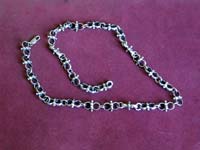 The experienced craftsman experiments with traditional techniques and forms, which he has inherited. By using his skillfulness, he creates modern compositions. These forms and shapes are inspired and usually refer to the classic and highly aesthetic art stereotypes. From the continuing morphological pursuit, the favourite subject of the creator is that of the sailing boats. These creations are the outcome of harmonic combinations of metal and stone while many different techniques are used. His elaborate chains, his small objects and the jewellery he creates, demonstrate the technical experience, the perfect knowledge of the material and the struggle of the designer, which is handed down from generation to generation, to create new cultural values. The experienced craftsman experiments with traditional techniques and forms, which he has inherited. By using his skillfulness, he creates modern compositions. These forms and shapes are inspired and usually refer to the classic and highly aesthetic art stereotypes. From the continuing morphological pursuit, the favourite subject of the creator is that of the sailing boats. These creations are the outcome of harmonic combinations of metal and stone while many different techniques are used. His elaborate chains, his small objects and the jewellery he creates, demonstrate the technical experience, the perfect knowledge of the material and the struggle of the designer, which is handed down from generation to generation, to create new cultural values.
|
